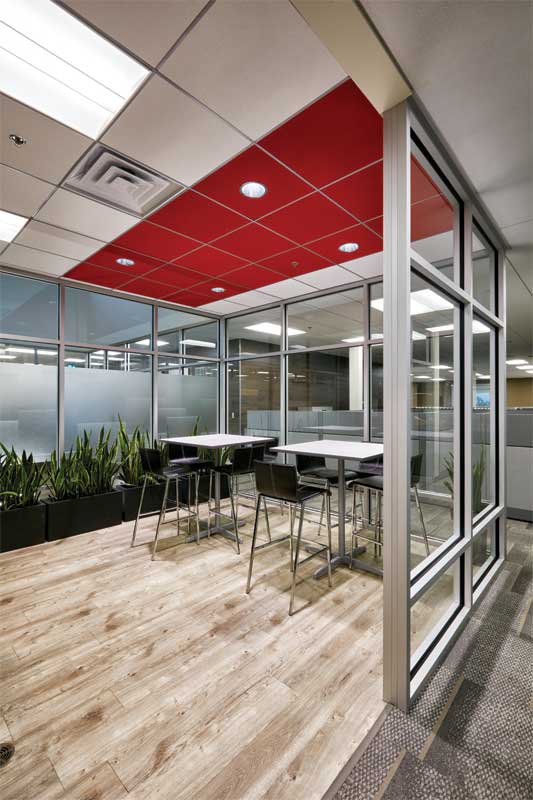Optimizing acoustics in offices

Ceilings are sound-absorbers
Acoustic ceiling panels are lightweight, weighing approximately 4.9 kg/m2 (1 lb/sf) or less. They are fibrous and porous, which makes them great at absorbing sound. Modern ceiling panels can offer far greater sound absorption than those used decades ago. Materials achieving NRC ratings of 0.90 or higher are considered high-performing, and should be used in large, open areas where medium to large groups of people work or gather.
The WELL Building Standard requires that 100 per cent of the ceiling over open offices or collaboration spaces be at least NRC 0.90, but not all spaces need values this high. Conference rooms, boardrooms, and training rooms can have ceilings with NRC ratings of 0.80 as long as the floor is also carpeted. In the past, a conference room with carpeting and acoustic wall panels may have required an NRC of only 0.60 for the ceiling—but if the carpeting and wall panels are removed, the ceiling now needs an NRC of 0.90 to maintain the same reverberation time. Private offices can have ceiling panels as low as NRC 0.70, but no one should use a ceiling panel below this level if people regularly occupy the space.
Modular acoustic ceiling systems are not massive enough to block sound. Additionally, ceilings are always penetrated by lights, open-air grilles, or loudspeakers that allow sound to leak through. This can likewise happen via gaps between the panels and the suspension grid. In fact, noise leaks can degrade the sound-blocking capability of the ceiling system by more than 20 decibels (dB) in the high frequencies that establish whether speech from an adjacent room is intelligible or disruptive. (A study on the effects of noise flanking paths on ceiling attenuation class (CAC) ratings of ceiling systems and inter-room speech privacy can be found in the proceedings of InterNoise 2015, co-written by A. Heuer and this article’s author.) If a sound is increased by 20 dB, it is subjectively perceived as being four times louder. Thus, a suspended acoustic ceiling should never be considered as a device for blocking sound. Ceilings are for sound absorption.

Photo © Bochler Creative (Burlington, Ont.). Photo courtesy Rockfon
Walls are sound-blockers
Walls are constructed of dense, relatively nonporous materials such as gypsum board, concrete, and masonry. They are also painted, which seals the pores even further. It is this mass and impenetrability that make walls excellent at blocking sound and conversely poor at sound absorption. Walls are for sound-blocking.
Stopping wall construction at the height of the ceiling, leaving an open plenum above rooms, and relying on the ceiling to block sound is an antiquated approach. This strategy is not permitted in current standards, guidelines, and building rating systems because it does not work effectively. In the past, some designers sacrificed absorption by accepting lower NRC values of 0.50 to 0.65 so they could have a ceiling panel with a higher ceiling attenuation class (CAC) rating of 30 to 35.
CAC is the metric that indicates a ceiling panel’s ability to block sound as it goes through the ceiling, over a partial-height wall, and back down through the ceiling in an adjacent room (i.e. double-pass). CAC only existed because of this compromised design approach, and may not be around much longer. It is no longer used in acoustic standards, guidelines, and rating systems.
The additional costs associated with extending the wall past ceiling height to the underside of the floor above is not always within the project construction budget. There is an alternative, optimal approach that achieves the desired acoustic performance at a significantly lower cost. Instead of extending up the entire wall construction, a lightweight plenum barrier can be installed vertically above the lower wall, which then blocks off the plenum acoustically. When combined with the use of a suspended ceiling, this approach provides effective sound blocking at the higher levels required by standards, guidelines, and building rating systems.
There are different material options for plenum barriers, some of which are likely to already be on the project site, such as a single layer of 16-mm (5/8-in.) thick gypsum board or 30-mm (1.2-in.) thick foil-faced stone wool insulation. The installation of these barriers does not always need to be time-consuming. Recent research shows that taping and caulking is not required to achieve a sound transmission class (STC) 40 level of isolation. Large holes around elements that penetrate the plenum barrier (i.e. ducts, pipes, and conduits) can simply be stuffed with fibrous insulation. An isolation level of up to STC 50 can be achieved if the plenum barrier is caulked or taped around the perimeter, along joints, and around penetrations. (A study on the optimizing of ceiling systems and lightweight plenum barriers to achieve CAC ratings of 40, 45, and 50, by the authors in note 3, may be found in the proceedings of Noise-Con 2016.)
Optimizing acoustics in larger, more-open commercial office buildings and compliance with standards and guidelines begins with effective noise absorption.







